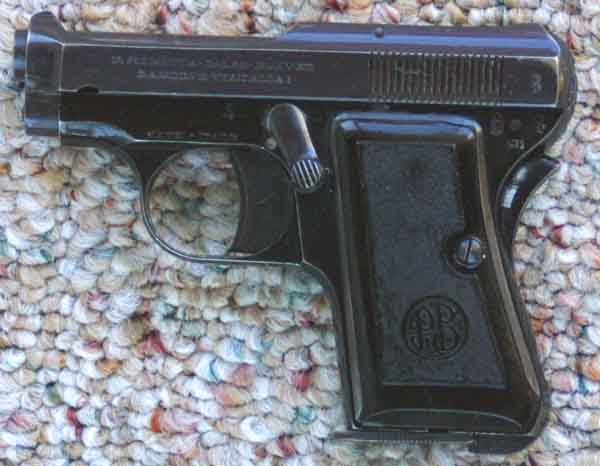 Beretta M-52
Beretta M-52
| Length overall | Barrel Length | Weight | Caliber | Action Type | Magazine Capacity |
| 4.75" | 2 3/8 " | .25 auto | Recoil Semi | 7+1 |
It has the distinctive open top shared by all Beretta pistols, and in it can be seen the embryonic lines of the later Jetfire, Minx, and Model 21 pocket pistols, as well as a bit of the influence of the well known 1934 series of pistols in .380. These guns were all produced before the Helwan, Brigadier, and other full sized pistols, which were to evolve into the Model 92 series. At the time, Beretta was known for small, pocket pistols. The company was not, then, particularly well respected by American handgun enthusiasts. Italian manufacturers, in general, were perceived as producers of stilettos, and switchblades, as well as nasty little cheap pistols, for hoodlums, and for housewives who didn't know any better. Guns like the M-52, as well made as it may have been, did not help.
It is chambered for that most horrible of all calibers, the .25 A.C.P. I consider the .22 to be a much better and more versatile caliber, it is also less expensive and does not have the unfortunate association with cheap "Saturday Night Specials" that the .25 A.C.P. does. In addition, the far less expensive 22 L.R. has about double the energy of the 25 auto.
The photo above shows the little M-52 with it's grip removed, showing the skeletal magazine in place. The photo to the left, shows the little M-52, alongside a current production Beretta M-21, in 22 L.R. There is a pretty strong family resemblance here, though something like forty years separates the design and production of these guns. In both cases, these guns are far better made, and far more fully featured, than the average vest pocket type of pistol.
Beretta is the oldest firearms company in the world, having started out by making cannon barrels in the fifteenth century. It is primarily known for it's great sporting shotguns; but has had considerable experience in producing military firearms, which far predates it's current production of the U.S. Army's M-9 series of handguns.
The little pocket pistols that Beretta produced in the forties, fifties, and into the sixties, were a way for the company to keep itself alive, after the Italian side lost World War Two. Descendants of these pistols are still produced today, in a number of variants, even as Beretta has become known as a maker of full sized pistols.
This little gun was the first Beretta I ever owned, and was bought at a gun show, back in the seventies. It is so small and thin, that I can carry it in a shirt pocket. It is now one of four Beretta pistols that I own, the others being a model 96, a model 21, and a BDA (marketed by Browning; but made by Beretta).
Disassembly
| After removing magazine, and checking chamber,
push up on slide lock, and leave it in place. |
|
| Pull the slide back, until it locks in place. |
|
| With the slide pulled back, the barrel may
be pulled back off of the frame, and up out of the slide. |
|
| With the barrel removed, release the slide.
|
|
| The slide may now be pulled forward off of
the frame. |
|
| The Beretta M-52 field stripped for cleaning.
The striker is visible, being held back by the sear, at the rear of the
frame. Pulling the trigger now will send the striker flying across the room. |